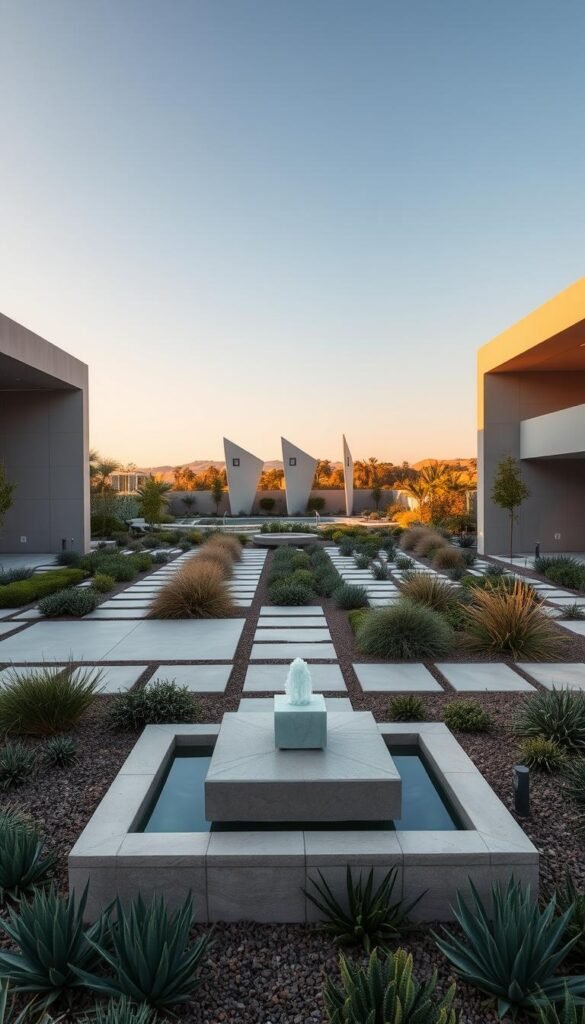Want to turn your backyard into a sleek retreat that matches your home’s style? Today’s approach to shaping outdoor areas focuses on clean layouts and purposeful features. Think crisp edges, subtle colors, and open zones that feel calm yet functional. Whether you’re starting fresh or updating existing elements, this style prioritizes simplicity without sacrificing personality.
Creating a cohesive look often starts with strategic planning. Many homeowners invest between $1,000 and $5,000 in professional guidance, ensuring every detail aligns with their vision. Materials and plants typically add $5,000–$20,000, while stone pathways or patios might cost $10,000–$30,000. These choices reflect a balance of beauty and practicality.
Neutral tones and geometric patterns help maintain visual harmony, letting greenery and textures shine. You’ll learn how to mix low-maintenance plants with structured elements like concrete or metal. The result? A seamless flow between indoor rooms and your revitalized yard—perfect for relaxing or entertaining.
This guide breaks down the core principles behind these transformations. Discover how thoughtful layouts and minimalist touches can elevate your property’s appeal while reflecting your unique taste.
Modern Outdoor Living: Fresh Perspectives and Bold Inspirations
Your outdoor area deserves the same attention as your living room—let’s make it shine. Today’s approach transforms yards into purposeful extensions of your home, blending comfort with striking visual statements. Start by asking: How do you want to live in this space? Is it for quiet mornings with coffee, lively weekend gatherings, or a mix of both?
Defining Your Modern Aesthetic
Your style sets the tone. Do sleek metal planters and angular seating speak to you? Or do warm wood accents paired with soft cushions feel more inviting? Look at your home’s architecture—its lines and materials should flow outdoors. A midcentury-inspired house might pair with geometric concrete pavers, while a farmhouse could balance weathered stone with crisp greenery.
Identifying Your Personal Style
Consider how you’ll use the space daily. Love hosting? Opt for a fire pit surrounded by modular seating. Prefer solitude? Create a zen corner with ornamental grasses and a water feature. Your choices should reflect both beauty and practicality—like selecting weather-resistant fabrics or native plants that thrive in your climate.
Remember, light exposure and existing trees influence your layout. A shaded patio might need brighter decor, while a sun-drenched deck benefits from shaded loungers. By aligning your design style with how you truly live, you’ll craft a space that feels effortlessly yours.
Contemporary Garden Design: Bold Ideas for a Modern Outdoor Space
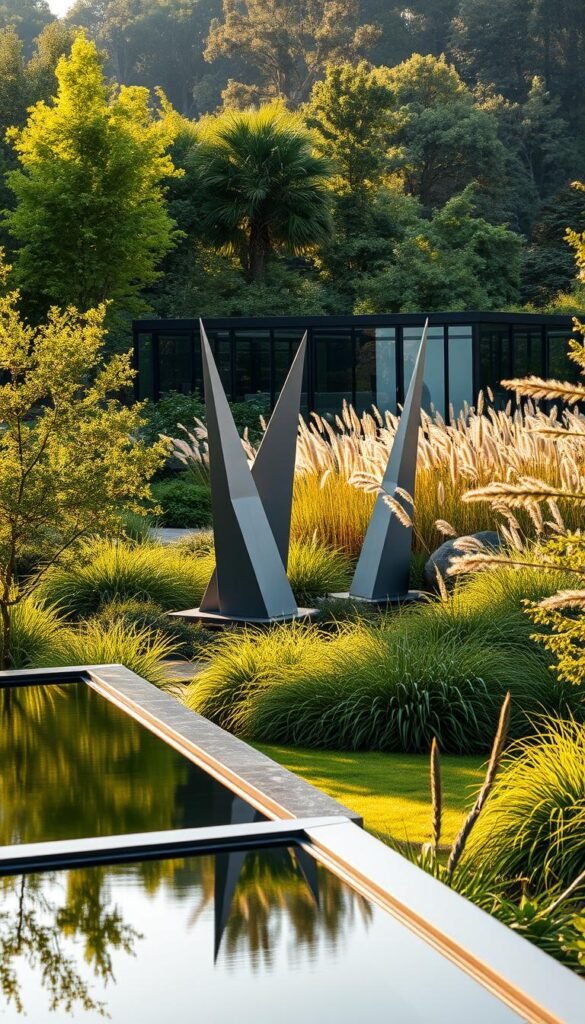
Discover how to blend functionality and artistry in your landscape with solutions that redefine outdoor living. Start by exploring structures like PowerGazebos—sleek shelters with integrated solar panels that provide shade while charging devices. These installations pair perfectly with minimalist layouts featuring gravel beds and sculptural succulents, creating focal points without clutter.
Vertical gardening offers smart space-saving potential. Stacked planter boxes or living walls add depth to small yards, especially when filled with drought-tolerant plants like lavender or agave. For inspiration on creative arrangements, check out these unique ways to decorate your outdoor.
Strategic use of negative space amplifies visual impact. Wide pathways of polished concrete contrast with tight clusters of ornamental grasses, guiding the eye through your backyard. Monochromatic schemes—think charcoal pavers against silver-leaf shrubs—keep the look cohesive yet striking.
Looking for more layout ideas? This guide to modern garden layouts shows how geometric patterns and architectural elements work together. Whether you’re crafting a serene retreat or an entertainment hub, these concepts adapt to any yard size, proving bold design doesn’t require endless maintenance.
Mastering Minimalism: Clean Lines and Geometric Shapes in Your Garden
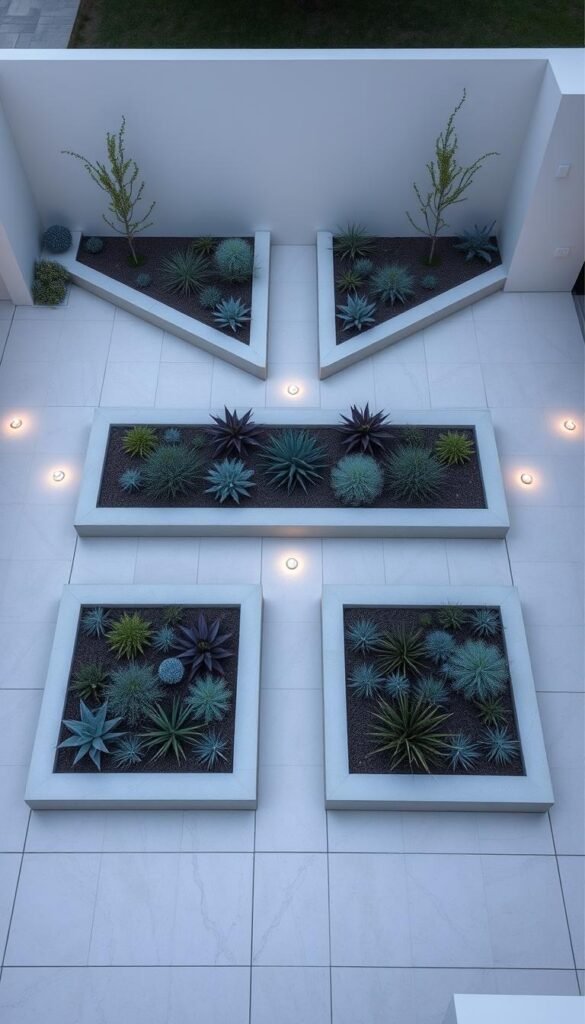
Transform your yard into a study of precision where every element serves a purpose. Minimalist landscapes thrive on intentional choices—think crisp angles, restrained palettes, and structured layouts that let materials and plants take center stage.
Exploring Geometric Plant Layouts
Create rhythm through repetition. Line up boxwood hedges in perfect rows or cluster ornamental grasses in triangular formations. Stick to 2-3 plant varieties with similar textures for cohesion. Japanese holly works well for sharp edges, while blue fescue adds soft movement within rigid frames.
Incorporating Hardscape Features
Ground your design with bold structural elements. Try these options:
- Interlocking concrete tiles forming hexagonal pathways
- Low retaining walls built from slate-colored stone
- Rectangular water basins framed in corten steel
Leave breathing room between features—negative space highlights your layout’s geometry. Pair smooth surfaces like polished aggregate with rough-cut stone for tactile contrast. This balance keeps the space feeling curated yet approachable.
Selecting Materials and Colors That Define Modern Elegance
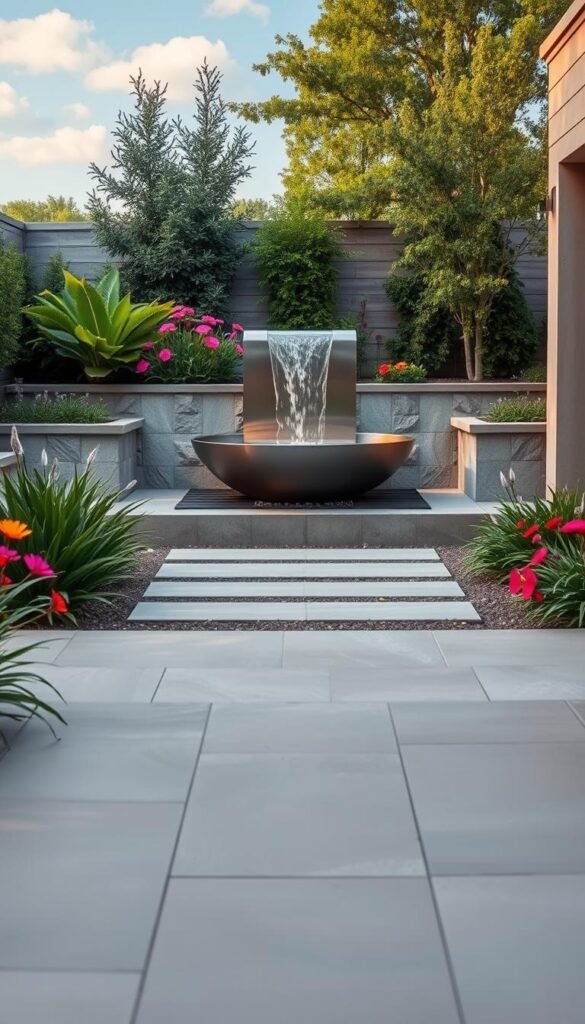
The secret to a polished outdoor area lies in materials that whisper sophistication while hugging nature. Start by balancing sleek surfaces with organic textures—this harmony keeps spaces feeling fresh yet welcoming.
Natural Stone, Metal, and Wood Accents
Concrete and steel form your foundation, but warmth comes through thoughtful pairings. Try these combinations:
- Polished concrete slabs edged with split-face limestone
- Stainless steel planters hugging oiled teak benches
- Weathered Cor-Ten steel screens behind smooth stucco walls
Davis Colors’ pebble-toned concrete adds subtle earthiness without losing edge. Use sandstone hues in pathways to mimic natural stone veins. These choices create visual depth while keeping maintenance low.
Wood accents break up cool materials. Cedar slats on overhead structures or ipe decking strips add warmth. Remember: materials like stone age beautifully, developing character over decades. Prioritize durability—choose granite over soft sandstone in freeze-thaw zones.
Stick to 2-3 dominant colors for cohesion. Charcoal grays pair with warm taupes, while metallic accents spark interest. Let your color palette flow from home exteriors to create seamless indoor-outdoor ties.
Designing Functional Outdoor Living and Entertaining Areas
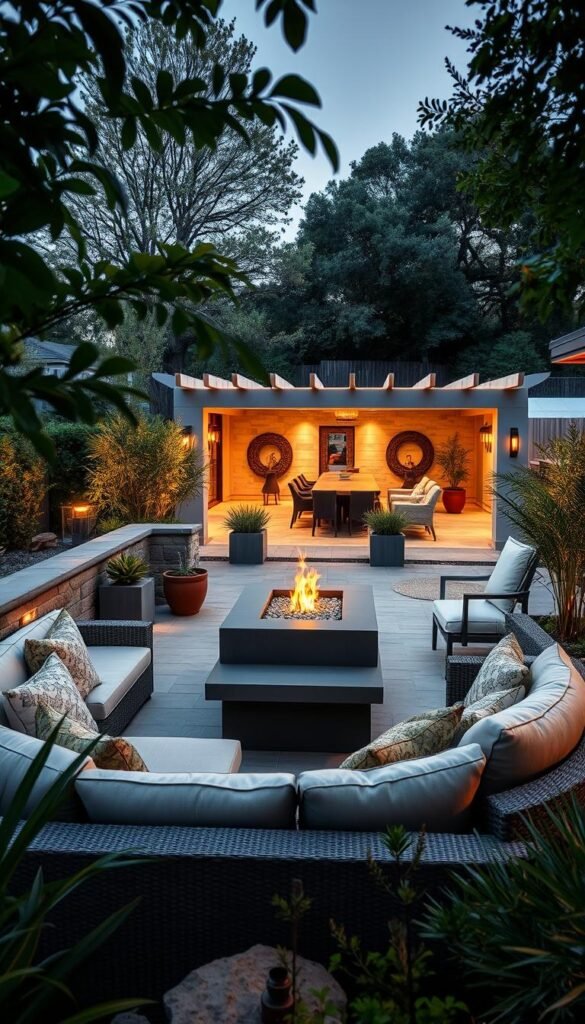
Transform your backyard into a versatile extension of your home where every gathering feels effortless. Smart layouts merge comfort with practicality, turning your outdoor space into multiple activity zones that work harder than your indoor living space.
Creating Dining and Lounge Spaces
Start by mapping traffic patterns between key areas. Allow 36 inches behind chairs for easy movement. Pair angular dining sets with circular fire pits to balance sharp lines. Modular sectionals let you rearrange seating for different group sizes.
Consider these popular configurations:
| Zone | Key Features | Materials | Seating |
|---|---|---|---|
| Dining | Weather-resistant table | Powder-coated steel | 6-8 guests |
| Lounge | Modular pieces | UV-resistant wicker | 4-6 guests |
| Kitchen | Built-in grill | Stainless steel | 2-3 bar stools |
Integrating Outdoor Kitchens and Fire Pits
Position cooking stations within 10 feet of indoor kitchens for easy access. Use matching countertop materials inside and out to blur boundaries. For fire features, surround stone-clad pits with low benches at 18-inch heights—perfect for leaning back comfortably.
Choose materials that handle heat and weather:
- Lava rock fillers for even heat distribution
- Pre-cast concrete burn bowls
- Perforated steel screens for spark protection
Your furniture choices make spaces work for family meals or late-night chats. Look for aluminum frames with quick-dry cushions—they withstand rain but feel cozy with throw pillows. Remember: durable doesn’t mean dull. Bright citrus tones pop against neutral stonework.
Smart Lighting Solutions: Creating Inviting Ambiances
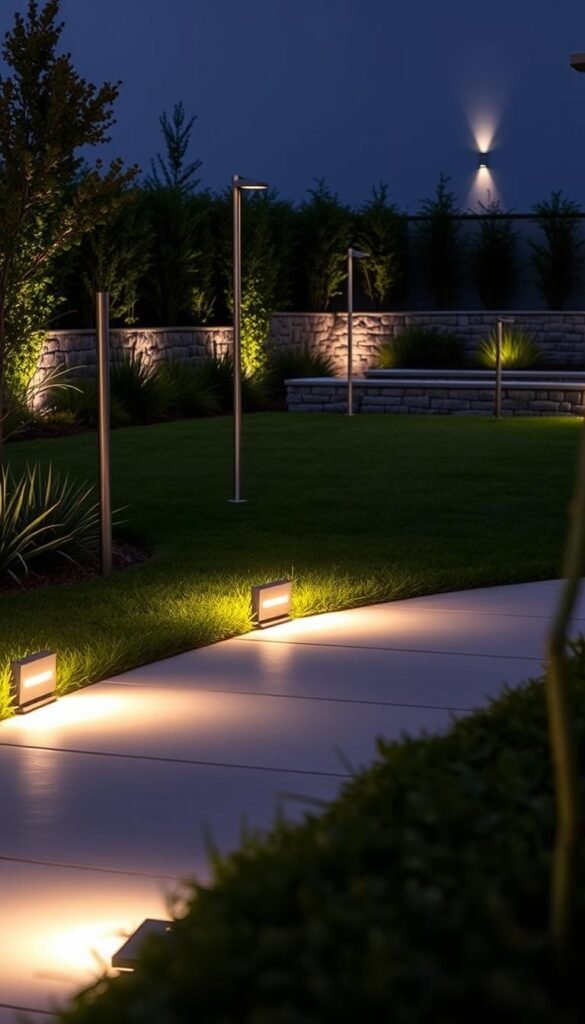
Lighting shapes how you experience your yard after sunset. Unlike harsh white beams that flatten textures, warm-toned LEDs wrap your space in a golden glow that feels welcoming. This approach transforms functional illumination into an art form, letting you enjoy evenings outdoors without sacrificing style.
Utilizing Warm LED Fixtures
Cool lighting (5000K+) creates stark shadows and sterile vibes. Instead, choose bulbs between 2700K-3000K color temperatures—they mimic candlelight’s cozy warmth. Matte bronze fixtures disappear into foliage better than reflective metals, keeping focus on your plants. For pathways, try recessed lights with honey-toned lenses that guide steps subtly.
Highlighting Garden Focal Points
Draw attention to standout features like sculptural trees or water features and fairy lights with directional LEDs. Uplight a Japanese maple’s canopy to cast dramatic silhouettes on walls. Downlighting from pergolas adds moonlight-like radiance over seating areas. These techniques add depth while maintaining minimalist aesthetics.
Layer three lighting types for balance: ambient (overhead), task (grilling zones), and accent (art pieces). Dimmable controls let you adjust atmosphere instantly—bright for dinners, soft for stargazing. With strategic placement, your nights outdoors become as thoughtfully designed as daytime views.
Sustainable Practices for a Contemporary Landscape
Building an eco-conscious landscape doesn’t mean sacrificing style—it’s about smarter choices that work with nature. By focusing on water-wise strategies and native plants, you create spaces that thrive with minimal effort. Let’s explore how to blend environmental responsibility with sharp aesthetics.
Choosing Drought-Resistant Plants
Native species are your best allies for low-maintenance beauty. Look for options like agave or yucca in dry climates—their sculptural forms fit sleek layouts perfectly. In wetter zones, try switchgrass or sedges that handle heavy rains while preventing soil erosion.
| Region | Plant Types | Water Needs |
|---|---|---|
| Arid | Barrel cactus, red yucca | Once monthly |
| Coastal | Seaside daisy, beach strawberry | Biweekly |
| Temperate | Purple coneflower, little bluestem | Weekly |
Eco-Friendly Irrigation Systems
Drip lines deliver water straight to roots, cutting waste by 50% compared to sprinklers. Pair them with rain barrels or underground cisterns to store stormwater. For larger projects, explore high-end landscape solutions that automate watering based on soil moisture sensors.
Rain gardens are another smart tool. They channel runoff into shallow basins filled with water-loving natives like iris or rush. These features reduce flooding while adding dynamic textures to your garden. Even urban spaces can benefit—check these container gardening ideas for small-scale sustainability.
Furniture and Accessories: Merging Style with Comfort
Your patio deserves pieces that feel like an extension of your personality. The right furniture balances sleek lines with plush comfort, creating zones that invite relaxation or lively conversations. Start by choosing pieces that match your style—whether that’s angular metal chairs or curved wicker loveseats with organic textures.
Material Choices for Lasting Appeal
Durability meets design in weather-resistant options. Aluminum frames withstand rain without rusting, while teak wood develops a silvery patina over time. Synthetic wicker offers the look of natural fibers with fade-resistant colors. Mix materials for contrast—try a steel dining table paired with cushioned rattan chairs.
| Material | Benefits | Color Options |
|---|---|---|
| Aluminum | Lightweight, rust-proof | Bold hues like cobalt |
| Teak | Natural warmth, ages well | Neutral tones |
| Synthetic Wicker | Weather-resistant | Earthy or vibrant shades |
Use colors to guide the eye. A crimson sofa becomes a focal point against gray pavers, while navy cushions echo nearby flower beds. Stick to 1-2 bold shades per area to avoid visual chaos. Neutral bases like charcoal or sand let brighter accents pop without overwhelming.
Accessorize with purpose. Waterproof throw pillows add a touch of pattern, while concrete side tables hold drinks without cluttering the space. Remember: every piece should enhance both seating comfort and your overall aesthetic vision.
Seamless Indoor-Outdoor Integration: Enhancing Your Home’s Living Space
Blurring the lines between inside and outside starts with smart layout choices. Your home gains depth when outdoor areas mirror interior flow, creating a sense of expanded living space. Focus on materials and sightlines that align with your architecture—this builds continuity without forcing matchy-matchy details.
Transitioning with Extended Patios and Sliding Doors
Extend your interior flooring material outdoors for instant cohesion. Porcelain tiles that stretch from the kitchen to the patio trick the eye into seeing one unified zone. Oversized sliding glass doors amplify this effect, erasing visual barriers while flooding rooms with natural light.
Strategic greenery placement strengthens the connection. Potted plants near thresholds echo indoor arrangements, while tall grasses along pathways guide movement. Keep color schemes consistent—if your living room features warm neutrals, repeat those tones in patio cushions or stonework.
These choices make entertaining effortless. Guests naturally drift between spaces, never feeling “outside” the gathering. With thoughtful planning, your property becomes a holistic environment where every corner feels intentional and inviting.

